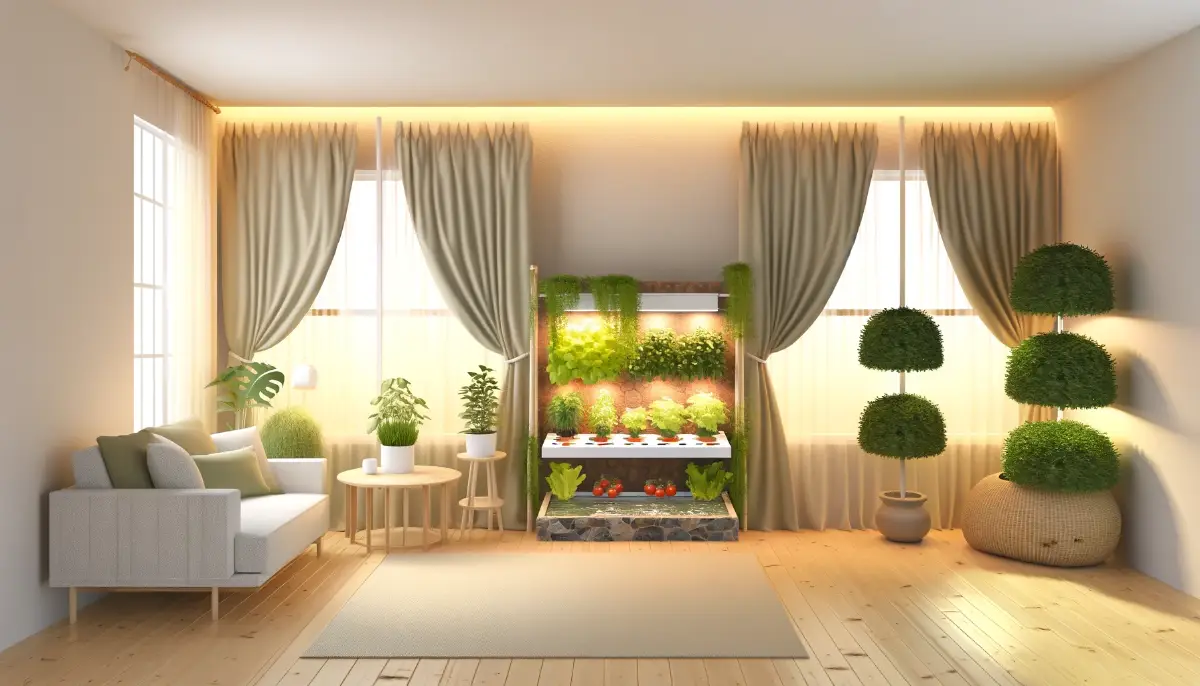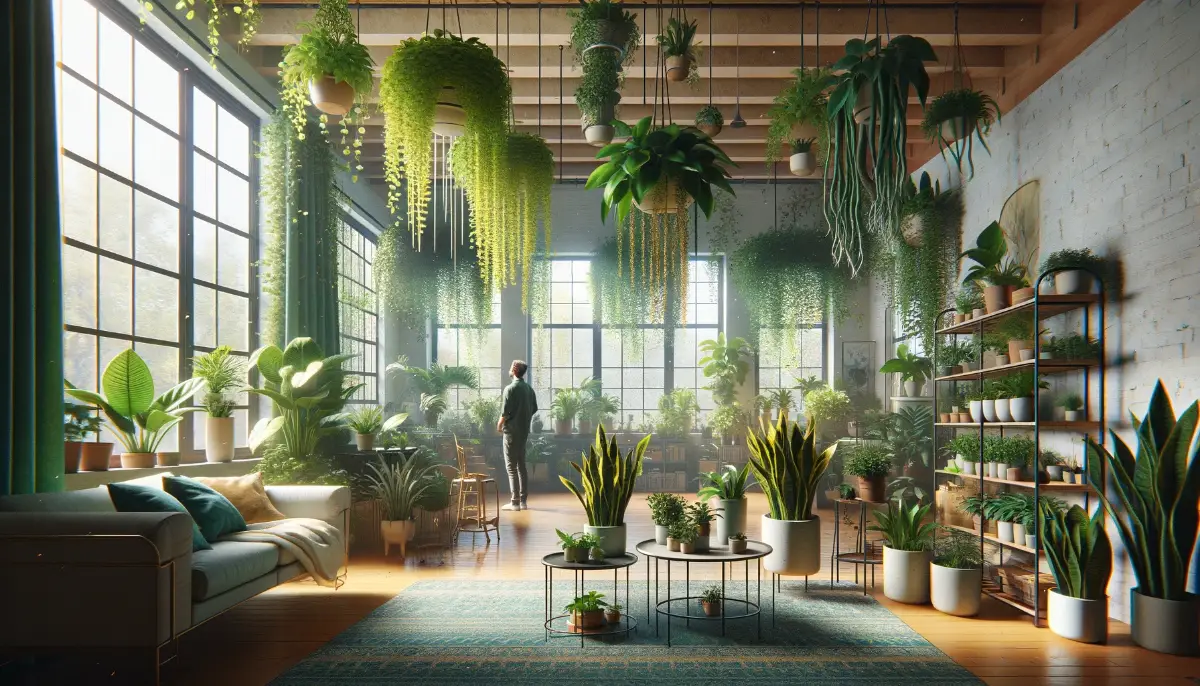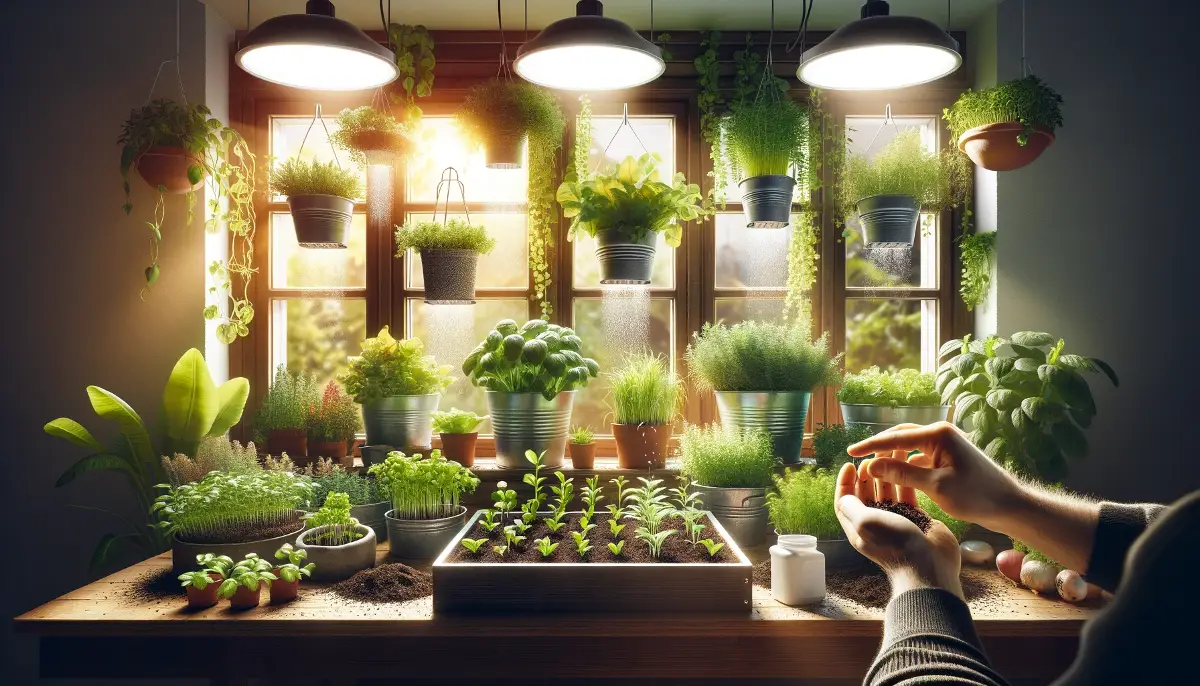Bringing the outside in has never been more stylish or beneficial. Interior gardens are not just about adding a touch of green; they’re about creating a living space that breathes life into your home.
From the lush tropics to minimalist havens, this guide will walk you through designing your very own interior garden.
- Choosing the right location and style for your garden is crucial.
- Vertical gardens and living walls are perfect for modern homes.
- Herb gardens offer beauty and utility in small spaces.
- Hydroponic gardens are a soil-free option for indoor greenery.
The Art of Location and Style in Interior Garden Design
The importance of selecting the right spot cannot be overstated. Your chosen location influences not just the garden’s growth but its integration into your home’s design. Consider spaces that blend seamlessly with your living areas, whether it’s a sunny corner of your living room or a dedicated room that allows for a more expansive setup.
Creating Harmony with Garden Styles: Each style has its unique charm and requirements. For instance:
- Tropical gardens thrive in warm, humid conditions, ideal for plants like ferns and ficus.
- Japanese gardens emphasize simplicity and are great for spaces aiming for a zen-like atmosphere.
- Minimalist gardens focus on small, evergreen plants, perfect for adding a touch of green without overwhelming the space.
- Rustic and modern styles offer a more traditional or contemporary flair, making your indoor garden a central part of your home’s decor.
1. Finding the Perfect Spot
The success of your indoor garden largely depends on where you place it. Plants need light to photosynthesize, so finding a spot with adequate sunlight is crucial. South-facing windows typically provide the most light, but if such a spot isn’t available, east or west-facing windows are the next best options. For homes with limited natural light, artificial grow lights can supplement or replace sunlight, ensuring your plants receive the energy they need to grow.
2. Choosing Your Green Companions
Deciding what to grow should be based on your space, light availability, and personal preferences. Start with easy-to-grow herbs like basil, mint, or cilantro if you’re a beginner. Vegetables like lettuce, spinach, and cherry tomatoes can also thrive indoors with proper care. Consider your dietary habits and try to grow what you love to eat, making your indoor garden both a joy and a resource.
3. Light It Right
Light is the life force of your garden. Each plant has specific light requirements, categorized into high, medium, and low light needs. High-light plants typically need about six hours of direct sunlight a day, while medium-light plants thrive in bright, indirect light. Low-light plants can grow in shadowy areas but still need some daylight to survive. Use a light meter to measure the light levels in different areas of your home to match plants to their preferred conditions.
4. The Ideal Temperature
Temperature plays a significant role in plant health. Most indoor plants prefer a consistent temperature between 65°F (18°C) and 75°F (24°C), mimicking their natural tropical or subtropical environments. Be wary of placing plants near air conditioning units, radiators, or drafty windows, as these can create temperature fluctuations harmful to your plants.
5. Get Creative with Containers
The containers you choose can add personality and style to your indoor garden. Beyond traditional pots, think about repurposing items like mugs, jars, or even old boots as planters. Whatever container you choose, ensure it has drainage holes to prevent water from pooling at the bottom, which can lead to root rot.
6. The Right Soil Mix
Indoor plants do best in potting mix designed for their specific needs. A good potting mix provides essential nutrients and allows for proper drainage and aeration. You can buy premixed potting soil or create your own mix tailored to your plants. Remember, garden soil is too dense for indoor plants and can contain pests and diseases.
7. To Seed or Not to Seed
Starting from seeds offers a wider variety of plant options and the satisfaction of growing from scratch. However, it requires more time and care. Seedlings give you a head start, ideal for seasonal plants or if you’re eager to see quicker results. Consider your patience level and the specific needs of the plants you want to grow.
8. Label and Organize
Keeping track of what you’ve planted, along with their specific care instructions, can help you maintain a healthy indoor garden. Use plant tags or create a garden journal to record planting dates, watering schedules, and any fertilizer requirements. This organization is especially helpful if you’re growing a variety of plants with different care needs.
9. Mulching Matters
Mulch isn’t just for outdoor gardens. Adding a top layer of mulch to your indoor plants can help retain soil moisture, suppress weeds, and add a polished look to your planters. Choose an indoor-appropriate mulch like coconut coir or moss to avoid pests.
10. Harvesting and Transplanting
The ultimate reward of an indoor garden is enjoying the fruits, herbs, or vegetables of your labor. Harvest regularly to encourage further growth, but be mindful not to over-harvest. Some plants will outgrow their containers and need transplanting to continue thriving. When transplanting, choose a pot that’s slightly larger than the current one to give your plant room to grow without overwhelming it.
FAQs About Indoor Garden Paradise
How often should I water my indoor garden?
Watering needs vary by plant, but a general rule is to water when the top inch of soil feels dry to the touch.
What are the best plants for low light areas?
Snake plants, pothos, and philodendrons are excellent choices for areas with low light.
Can I use outdoor soil for my indoor garden?
It’s best to use a potting mix designed for indoor plants, as outdoor soil may contain pests and weeds.
How do I know if my plants are getting enough light?
Plants that aren’t getting enough light may exhibit slow growth, pale leaves, and leggy stems. Consider moving them closer to a light source or supplementing with artificial light.
Can indoor gardening help purify air?
Yes, plants like spider plants, peace lilies, and rubber plants are known for their air-purifying abilities.
How can I add humidity for my tropical plants?
Place a humidifier nearby or create a pebble tray with water to increase humidity around your tropical plants.
What should I do if my plant’s leaves turn yellow?
Yellowing leaves can be a sign of overwatering, under-watering, or nutrient deficiency. Adjust your care accordingly.
Can I grow vegetables indoors?
Absolutely. Leafy greens, herbs, and dwarf varieties of tomatoes and peppers can thrive in indoor conditions.
How do I deal with pests in my indoor garden?
Use natural remedies like neem oil or insecticidal soap to combat pests. Regularly inspecting your plants helps catch infestations early.
Is it expensive to start an indoor garden?
The initial setup can be a bit of an investment, but many find the benefits of having fresh herbs, vegetables, and the beauty of indoor plants well worth the cost.









